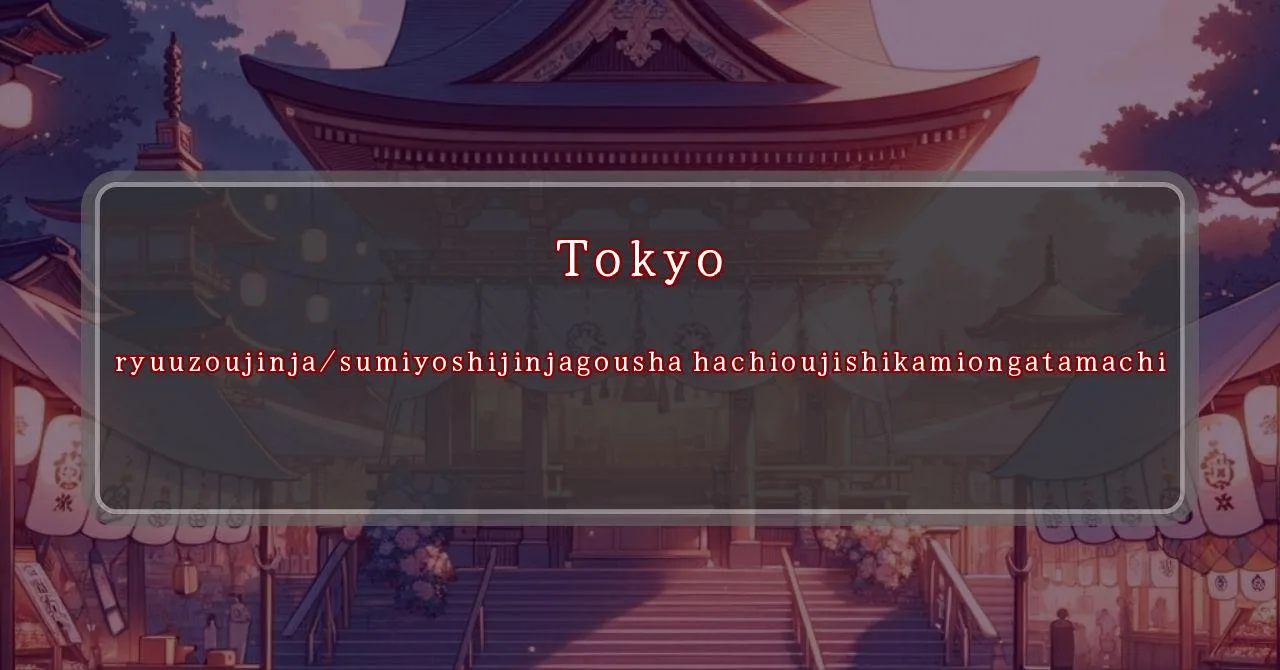Enchanting shrine festival with a history of over 1000 years
Basic Information
Ryuzoshrine/Sumiyoshi Shrine Joint Shrine is a shrine located in Kamihonkatacho, Hachioji City, Tokyo. It is classified as a former village shrine in the modern shrine ranking system.
- Address: 2799 Kamihonkatacho, Hachioji City, Tokyo 192-0156
- Phone Number: Not Available
- Access: About 2.5km from Yuuyakekoyake Fureainosato
- Festival Days: Second Sunday of September
Main Events and Attractions of the Festival
The Ryuzoshrine/Sumiyoshi Shrine Joint Shrine Festival is held annually on the second Sunday of September. The festival features various events and attractions that draw visitors from near and far.
Mikoshi Procession
The highlight of the festival is the mikoshi procession, where a portable shrine is carried through the streets of Kamihonkatacho. The mikoshi is decorated with colorful tapestries and carried by a team of people. The procession is accompanied by music and dancing, creating a lively and festive atmosphere.
Lion Dance
Another popular attraction of the festival is the lion dance. The lion dance is performed by a team of dancers wearing lion costumes. The dancers perform acrobatic stunts and interact with the crowd, bringing joy and laughter to the festival.
Taiko Drumming
Taiko drumming is a traditional Japanese art form that involves playing large drums. During the festival, taiko drummers perform rhythmic and energetic beats, adding to the excitement of the event.
Benefits and Deities
The Ryuzoshrine/Sumiyoshi Shrine Joint Shrine is dedicated to several deities, including the gods of rain, safe childbirth, and good fortune. Visitors to the festival can pray for blessings and good luck in these areas.
History and Origin
The history of the Ryuzoshrine/Sumiyoshi Shrine Joint Shrine dates back over 1,000 years. The shrine was originally established in the Heian period (794-1185) and has been rebuilt and renovated several times over the centuries. The current shrine buildings date back to the Meiji period (1868-1912).
Blessings and Deities
The Ryuzoshrine/Sumiyoshi Shrine Joint Shrine is dedicated to several deities, each with their own unique blessings and powers.
- Iwatakihime no Mikoto: The goddess of rain and water. She is believed to bring abundant rainfall and protect against droughts.
- Sokotsutsu no Oomikami: The god of the earth and mountains. He is revered for his role in providing stability and protection.
- Nakatsutsu no Oomikami: The god of the middle world, which includes the human realm. He is associated with harmony and balance.
- Uwatsutsu no Oomikami: The god of the heavens and sky. He is believed to bring good weather and protect against storms.
- Jingu Kogo: The legendary empress who led an army to victory in Korea. She is revered for her courage and leadership.
- Omononushi no Mikoto: The god of medicine and healing. He is believed to cure illnesses and protect against disease.
- Sutoku Tenno: The former emperor who was exiled to the mountains. He is revered for his resilience and perseverance.
Origin and History
The history of the Ryuzoshrine/Sumiyoshi Shrine Joint Shrine dates back over 1,000 years.
- Heian Period (794-1185): The shrine is believed to have been founded during this period, dedicated to the god of rain, Iwatakihime no Mikoto.
- Kamakura Period (1185-1333): The shrine is rebuilt and expanded.
- Muromachi Period (1336-1573): The shrine is damaged by fire and later restored.
- Edo Period (1603-1868): The shrine is again rebuilt and renovated.
- Meiji Period (1868-1912): The shrine is merged with the Sumiyoshi Shrine, and the current shrine buildings are constructed.
Tips and Notes for Visitors
Here are some tips and notes for visitors to the Ryuzoshrine/Sumiyoshi Shrine Joint Shrine:
- Dress Code: Visitors are expected to dress respectfully when visiting the shrine. Avoid wearing shorts, tank tops, or other casual clothing.
- Photography: Photography is generally allowed within the shrine grounds, but it is important to be respectful of other visitors and avoid taking pictures during religious ceremonies.
- Offerings: Visitors can make offerings to the deities at the shrine by placing coins in the offertory box. It is customary to bow before and after making an offering.
- Ema: Visitors can also purchase ema (wooden plaques) at the shrine and write their wishes or prayers on them. The ema are then hung up at the shrine, where they are believed to be carried to the gods by the wind.
- Festivals: The shrine holds several festivals throughout the year, including the annual festival in September. Visitors can enjoy traditional Japanese music, dance, and food at these festivals.
Parking Information
There is no dedicated parking lot for the Ryuzoshrine/Sumiyoshi Shrine Joint Shrine. However, there are several public parking lots in the vicinity of the shrine.
- Yuuyakekoyake Fureainosato Parking Lot: This parking lot is located about 2.5 kilometers from the shrine.
- Wada峠Parking Lot: This parking lot is located about 3.5 kilometers from the shrine.
Popular Stalls and Food Carts in Recent Years
| Type of Stall | Description |
|---|---|
| Takoyaki | A staple at Japanese festivals. Characterized by a crispy outside and a creamy inside. |
| Jaga Butter | A simple yet popular snack of hot potatoes lavishly topped with melted butter. |
| Baby Castella | Small castella cakes, sweet and fluffy treats enjoyed by children and adults alike. |
| Grilled Ayu with Salt | Fresh ayu fish grilled whole with salt, a savory taste of Japanese summer. |
| Shaapin | A unique gourmet item influenced by foreign cuisine, with a chewy skin wrapping the filling. |
| Okonomiyaki | A Japanese grilled dish where you often choose your own ingredients for a personalized flavor. |
| Cotton Candy | A fluffy, sweet snack that’s extremely popular with children. |
| Chocolate Banana | A banana coated in chocolate, a fun and visually appealing dessert. |
| Kushiyaki | Various types of ingredients skewered and grilled, an easy-to-enjoy snack. |
| Yakisoba | Fried noodles mixed with a special sauce, a fast food favorite in Japan. |



